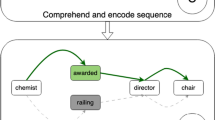Abstract
Do native speakers always outperform second-language (L2) learners in terms of speech processing accuracy? Surprisingly, the answer to this seemingly obvious question is no according to the study reported here. Indeed, native speakers sometimes make more errors than learners in interpreting their own first-language (L1) speech. In this competition experiment of the double-object active and transitive causative sentence processing strategies, six native Japanese speakers and nine English-speaking learners of Japanese participated. The participants were required to identify the agents of the main lexical verb (“doers”) of a series of Japanese sentences, each consisting of one verb and three noun phrases, in which word order and case-marking cues either competed or were consistent with each other. In the first (pretest) and last (posttest) parts of the study, participants received no feedback about the accuracy of their responses, whereas in the middle part they received immediate feedback. The stimulus sentences were such that a listener could determine the semantic role of noun phrases (actor, causer, or recipient) only by taking into consideration both the case markers and the verb's voice (active vs. causative).
Learners of Japanese as a second language (JFLs) demonstrated an evident word order bias. Native Japanese speakers also made surprisingly numerous errors, by imposing the canonical case-marker sequence in reconstructing noncanonical sentences. Indeed some of the native Japanese revealed an even stronger word order bias than the learners, and they committed more errors than learners in interpreting noncanonical word order sentences. The results are explained in terms of the working memory constraint. Directions of further research are discussed.
Similar content being viewed by others
REFERENCES
Bates, E., Friederici, A. D., & Wulfeck, B. (1987). Comprehension in aphasia: A cross-linguistic study. Brain and Language, 32, 19–67.
Bates, E., & MacWhinney, B. (1981). Second-language acquisition from a functionalist perspective: Pragmatic, semantic, and perceptual strategies. In H. Winitz (Ed.), Annals of the New York Academy of Sciences of conference on native & foreign language acquisition (pp. 190–214). New York: New York Academy of Sciences.
Bates, E., & MacWhinney, B. (1989). Functionalism and the competition model. In B. MacWhinney & E. A. Bates (Eds.), The cross-linguistic study of sentence processing (pp. 3–73). New York: Cambridge University Press.
Bates, E., & Wulfeck, B. (1989). Crosslinguistic studies of aphasia. in B. MacWhinney & E. A. Bates (Eds.), The cross-linguistic study of sentence processing. (pp. 328–371) New York: Cambridge University Press.
Heilenman, K. L., & McDonald, J. L. (1993). Processing strategies in L2 learners of French: The role of transfer. Language Learning, 43, 507–554.
Kilborn, K. (1987). Sentence processing in a second language: Seeking a performance definition of fluency. Unpublished doctoral dissertation, University of California, San Diego.
Kilborn, K. (1991). Selective impairment of grammatical morphology due to induced stress in normal listeners: Implications for aphasia. Brain and Language, 41, 275–288.
MacWhinney, B., & Bates, E. (Eds.). (1989). The crosslinguistic study of sentence processing. New York: Cambridge University Press.
MacWhinney, B., Osman-Sagi, J., & Slobin, D. I. (1991). Sentence comprehension in aphasia in two clear case-marking languages. Brain and Language, 41, 234–249.
McDonald, J. L. (1987). Sentence interpretation in bilingual speakers of English and Dutch. Applied Psycholinguistics, 8, 379–413.
McDonald, J. L. (1989). The acquisition of cue-category mappings. In B. MacWhinney & E. Bates (Eds.), The crosslinguistic study of sentence processing. (pp. 375–396) New York: Cambridge University Press.
McDonald, J. L. & MacWhinney, B., (1991). Levels of learning: A comparison of concept formation and language acquisition. Journal of Memory and Language, 39, 407–430.
Miyake A. (1994). Toward a unified theory of capacity constraints: The role of working memory in complex cognition. Cognitive Studies: Bulletin of the Japanese Cognitive Science Society, 1, 43–62.
Miyake, A. & Friedman, N. (in press). Individual differences in second language proficiency: Working memory as “Language aptitude”. In, Healey, A. & Bourne, L. (Eds.), Foreign language learning: Psycholinguistic studies on training and retention. Mahwah, NJ: Erlbaum.
Nagara, S. (Ed.). (1990). Japanese for everyone. Tokyo, Japan: Gakken.
Omaggio-Hadley, A. (1993). Teaching language in context (2nd ed.). Boston, MA: Heinle & Heinle.
Sasaki, Y. (1991). English and Japanese interlanguage comprehension strategies. Applied Psycholinguistics, 12, 47–73.
Sasaki, Y. (1992). Paths of processing strategy transfers in learning Japanese, and English as foreign languages: A competition model approach. Unpublished doctoral dissertation, University of Illinois at Urbana-Champaign.
Sasaki, Y. (1994a). A study guide and exercise book for “Japanese for everyone” (Lesson 14 ~ 26). Unpublished course packet, University of Massachusetts.
Sasaki, Y. (1994b). Paths of processing strategy transfers in learning Japanese and English as foreign languages: A competition model approach. Studies in Second Language Acquisition, 16, 329–350.
Slobin, D. I. (1979). Psycholinguistics (2nd ed.). London, England: Scott, Foresman.
Taira, N. (1994). Intermediate Japanese role-play kits. Unpublished course packet, University of Massachusetts.
Author information
Authors and Affiliations
Rights and permissions
About this article
Cite this article
Sasaki, Y. Processing and Learning of Japanese Double-Object Active and Causative Sentences: An Error-Feedback Paradigm. J Psycholinguist Res 27, 453–479 (1998). https://doi.org/10.1023/A:1023208703600
Issue Date:
DOI: https://doi.org/10.1023/A:1023208703600




